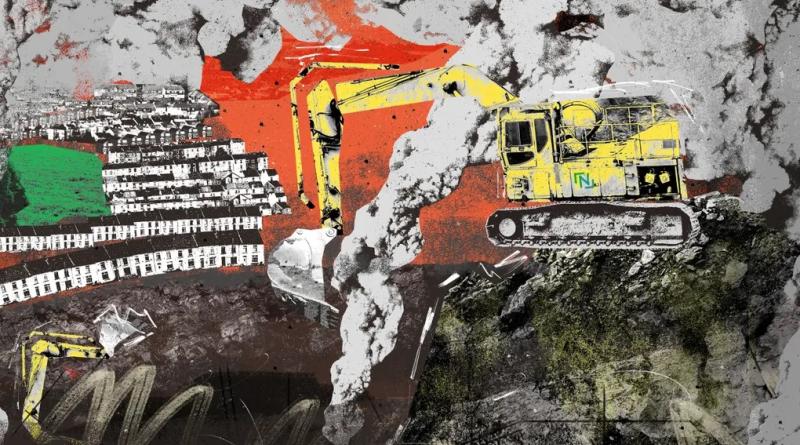As the toxic legacy of opencast mining in Wales shows, operators get the profits, and the public get the costs

Across the UK, fossil fuel companies’ broken promises have left scarred and polluted landscapes, and no one held accountable.
When you’re in a hole, keep digging. This is the strategy of opencast miners across the world: our past debts and future liabilities can one day be discharged if only we’re allowed to dig a little deeper and extract a little more. And public authorities keep falling for it.
The UK’s biggest opencast coalmine, Ffos-y-Fran in south Wales, was granted permission in 2005 on the grounds that it would rehabilitate a hill, on the outskirts of Merthyr Tydfil, which had been made dangerous by the shafts and spoil heaps left by deep mining. It wasn’t called a coalmine, but a “land reclamation scheme”. If the reclaimers happened to stumble across 11m tonnes of coal while improving the land by digging a 400-hectare (1,000-acre) pit, 200 metres deep, who could blame them for taking it?
In 2007, as the works commenced, I wrote an article arguing that, as local people had pointed out, there were much simpler, quicker and more reliable ways of reclaiming the land, which did not involve ruining people’s lives by blasting, digging and trucking for 17 years, and releasing 30m tonnes of carbon dioxide from the coal extracted. But the council, under pressure from Tony Blair’s government, had bought into the story. It even allowed the miners to work without the usual protections for local people, encroaching to within 36 metres of some homes.
Never mind: after 17 years of hell, the land would be restored, using some of the money made by extracting the coal. The hole would be filled and the hill rebuilt. The mining company, originally Miller Argent, now Merthyr (South Wales) Ltd, would deposit the reclamation money in an escrow account held by the council. But in 2014, the Welsh government warned that only £15m had been deposited in this account, while the reclamation might cost £50m.
Since then, the price of coal has boomed, but the fund still stands at £15m, while the estimated cost of filling the hole and restoring the landscape has risen to between £75m and £125m. The rehabilitation was supposed to be completed by the end of next year, but there is no sign it has begun. Far from reclaiming the land, the mine has created a much bigger problem: where the hill stood in 2007, there is now a great pit above whose sheer sides the homes of local people perch.
So last year the company applied to the council again. With astonishing chutzpah, it argued that it should be allowed to extend its mining beyond the agreed deadline of September 2022, to make more money, on the grounds that “there are insufficient funds within the escrow and restoration fund to allow for the full and successful implementation of the current restoration strategy for the site”.
This time the council wasn’t fooled. It refused permission. But reports in the Guardian and Private Eye over the past fortnight suggest that unauthorised mining by the company has continued at Ffos-y-Fran.
There are similar issues with pits across south Wales. In 2010, a company called Celtic Energy sold its opencast coalmines – with its restoration liabilities – for £1 apiece to a series of shell companies it had set up in the British Virgin Islands. Then the senior executives walked away with millions. Six people were charged with fraud, but the judge found that, while some might regard their actions as “dishonest” or “reprehensible”, they were not illegal.Today, the four giant holes dug by Celtic Energy – East Pit, Nant Helen, Margam and Selar – remain unrestored or partly restored. Land that was supposed to have been rehabilitated into country parks, tourist attractions or housing developments is instead blighted by bare spoil heaps, drums of chemicals, rusting machinery and steep drops into pools of filthy water. As at Ffos-y-Fran, Celtic Energy applied for extensions, arguing they were necessary to pay for land restoration, but the net result was bigger holes.
In East Ayrshire in Scotland, Clay Cross in Derbyshire and several other parts of the country where coal has been mined, broken promises have left communities with a broken land. It’s a classic privatisation disaster. When coal was privatised by John Major’s government in 1994, the new companies were granted a 10-year exemption from having to pay the money that should be set aside for decommissioning the mine. In return, they agreed to buy the right to mine at a higher cash price. In common with other privatisations – which could be characterised as legalised theft from the public realm – this higher price was still well below the potential value of the assets. To make matters worse, the requirement to start paying into escrow accounts after 10 years was not backed by effective legislation. The companies got the profits, the public got the costs.
Now, as well as land blight, there is a potential toxic legacy. Disused mines are one of the most potent sources of water pollution, and can keep discharging for hundreds of years. The River Esk in Scotland, for example, is still being polluted by coal workings from the 13th century. As the opencast pits fill with water, into which sulphides and metal salts leach, these toxins can spread into aquifers, drain into rivers and contaminate the land when rivers flood. No one seems to have a plan for averting this outcome.
There are similar stories in many parts of the world. In the Appalachians and the Illinois basin in the US, coal companies have walked away from environmental disasters. Homes are flooded by minewater, rivers are poisoned, mountaintops remain truncated.
One estimate suggests there are also 123,000 abandoned, uncapped oilwells in the US; another that plugging the derelict oil and gas wells in the Gulf of Mexico alone – which threaten to discharge methane into the atmosphere and crude oil into the ocean – would cost $30bn. Most of this money should be provided by the oil majors that drilled them, which have a combined capitalisation of $1.2tn, but they are surrounded by the defensive political wall they have bought: the state and federal legislators who obstruct any attempt to hold them to account. In the Niger delta in Nigeria, blighted by decades of oil spills, many people now have no option but to abandon their poisoned lands and seek to rebuild their lives elsewhere.
It’s capitalism made visible: extract the money, dump the costs, abandon the community and move to the next frontier. And this is before you count the much greater liability of the carbon dioxide these corporations have released, for which there was never a clean-up plan. We are all in the hole the fossil fuel companies have left. It is time to stop digging.
cover photo:Illustration: Nate Kitch






